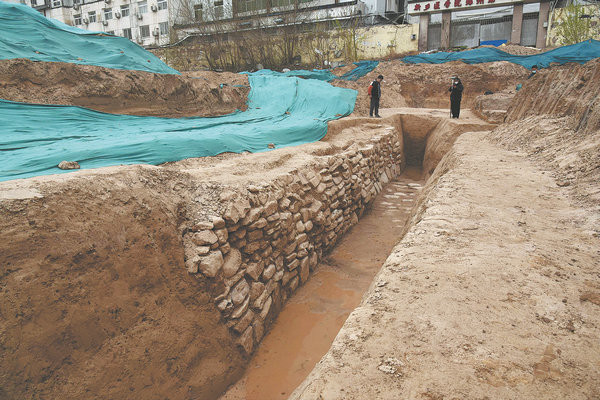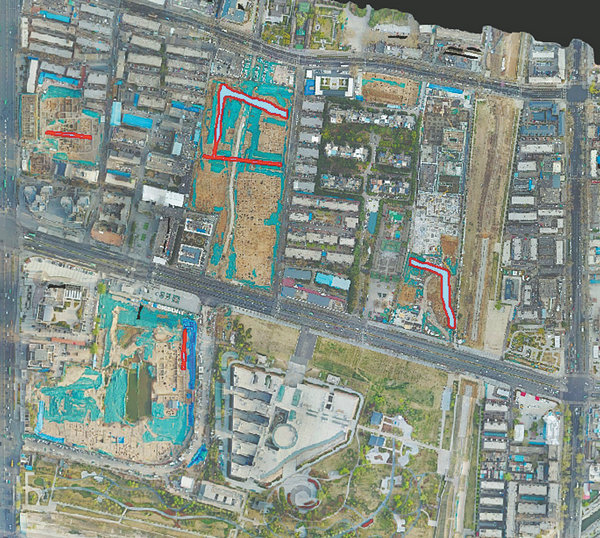
Archaeologists at the site where three early Shang Dynasty (c. 16th century-11th century BC) ditches were recently unearthed, in what is now Zhengzhou, Henan province.
Researchers from the Henan Provincial Institute of Cultural Heritage and Archaeology have recently made a major breakthrough at the Shang Dynasty (c. 16th century-11th century BC) capital city ruins in Zhengzhou, Henan province.
Their findings shed new light on the sophistication of its urban planning mechanism and water systems, features of early civilization that were less well-known but nonetheless of great importance.
The finding, which consists of the largest water system remains from the early Shang Dynasty found to date, has filled a critical gap in comprehending the spatial layout of the southern section of the Zhengzhou Shang City, an archaeological site of the Bronze Age Erligang Culture in Central China.
Current studies give it four chronological phases from 1630 to 1400 BC.
The ruins, which date back more than 3,600 years, are situated in the heart of historical Zhengzhou city, encompassing a sprawling area of 25 square kilometers. Academically, it has been widely recognized as the capital established by the first ruler of the Shang Dynasty, and played a pivotal role in the later development of Shang civilization, which was mainly centered in the Yellow River Basin.
The Shang Dynasty is universally known for its sophisticated oracle bone inscriptions and mysterious use of complex bronze ware at ritual and religious celebrations, at a time when most Western contemporaries were simply using bronze to make tools or weapons.
Archaeological experts at the site recently unearthed three early Shang Dynasty ditches located in the southeastern region of the site of Shang City's inner city in Zhengzhou. These ditches, distinguishable by their large openings and relatively narrow bottoms, represent a remarkable ancient engineering feature.
One of them displayed signs of being adapted from a natural river channel, while the other two were entirely human-made. The ditches stretch approximately 540 meters, with the widest point reaching 12 meters and the deepest point descending about 4 meters.

Yang Wensheng, deputy director of the Henan Provincial Institute of Cultural Heritage and Archaeology, emphasizes the historical significance of this finding. He says that compared with the water system at the site of Shang City in Yanshi district, Luoyang city in Henan from the same period, the newly discovered water system in Zhengzhou Shang City surpasses it in both scale and extent.
Unusually, archaeologists also uncovered artificially opened ditches and stone water retaining structures for diversion within one of the ditches. This suggests that during the early Shang Dynasty, the water network system in Zhengzhou Shang City exhibited intricate functional designs. Alongside the ditches, remains of rammed earth buildings and workshops dedicated to crafts, such as copper casting and bone carving, were also unearthed.
The most intriguing aspect of the newly revealed water system is its connection to a northern pond in the southeastern region, suggesting a dual purpose for this extensive water network.
According to Yang Shugang, director of the Zhengzhou work station of the Henan Provincial Institute of Cultural Heritage and Archaeology, the large water system has the functions of both drainage and urban division. Its discovery is poised to rewrite the previous understanding of the overall layout of Zhengzhou Shang City, and is a great contribution to the in-depth exploration of the early Shang Dynasty.
In the forthcoming phases of the archaeological endeavor, researchers will continue their excavations and research activities. Their aim is to deepen understanding of various aspects of the water system, including its origins, purpose, abandonment, maintenance and construction techniques.
Additionally, they will investigate the relationship between the city's artificial water network and the natural water system surrounding it. This multidisciplinary approach will facilitate comprehensive research encompassing urban water conservancy, geomorphological environment, construction technology and much more.
For archaeologists and scholars, the discovery of the water system is undoubtedly a remarkable achievement in the field. It not only offers fresh insights into the research and study of the early Shang Dynasty, but also underscores the advanced engineering prowess and urban planning of China's ancient civilization, enriching the world's understanding of the country's ancient past.
Shi Baoyin in Zhengzhou contributed to this story.
Source: Chinadaily